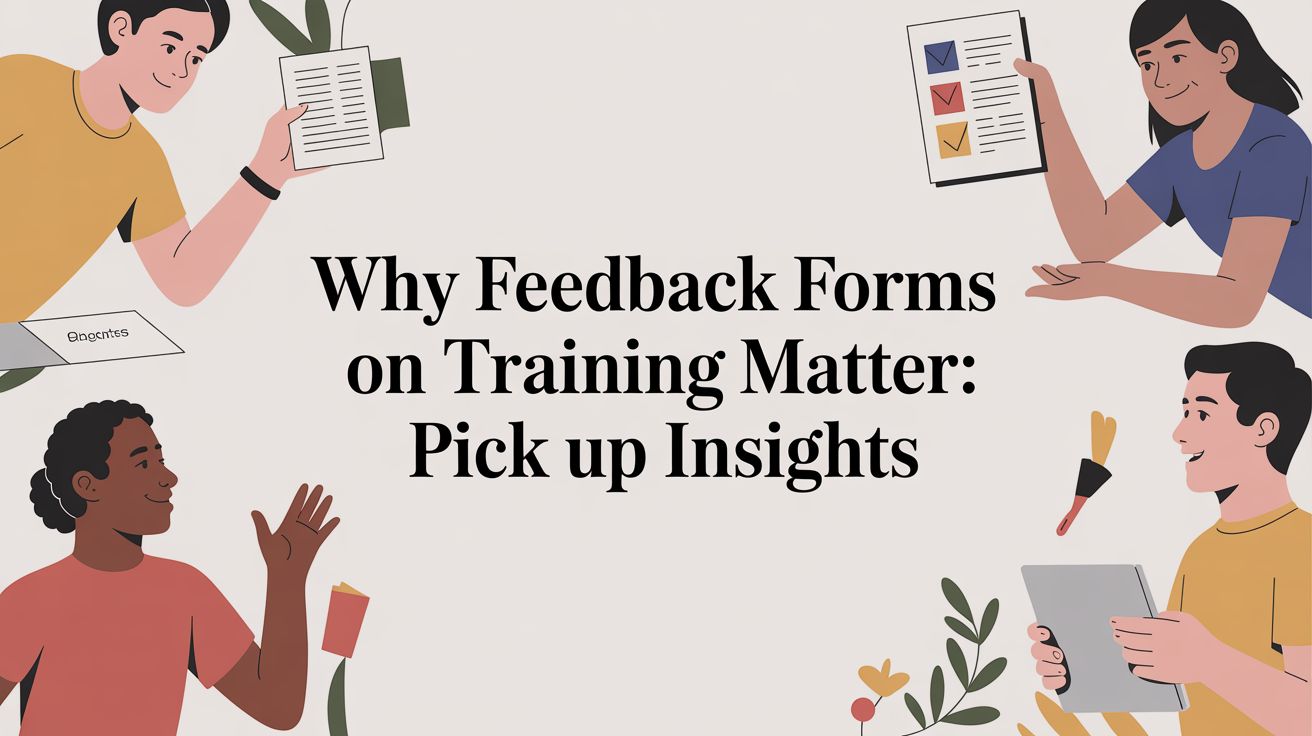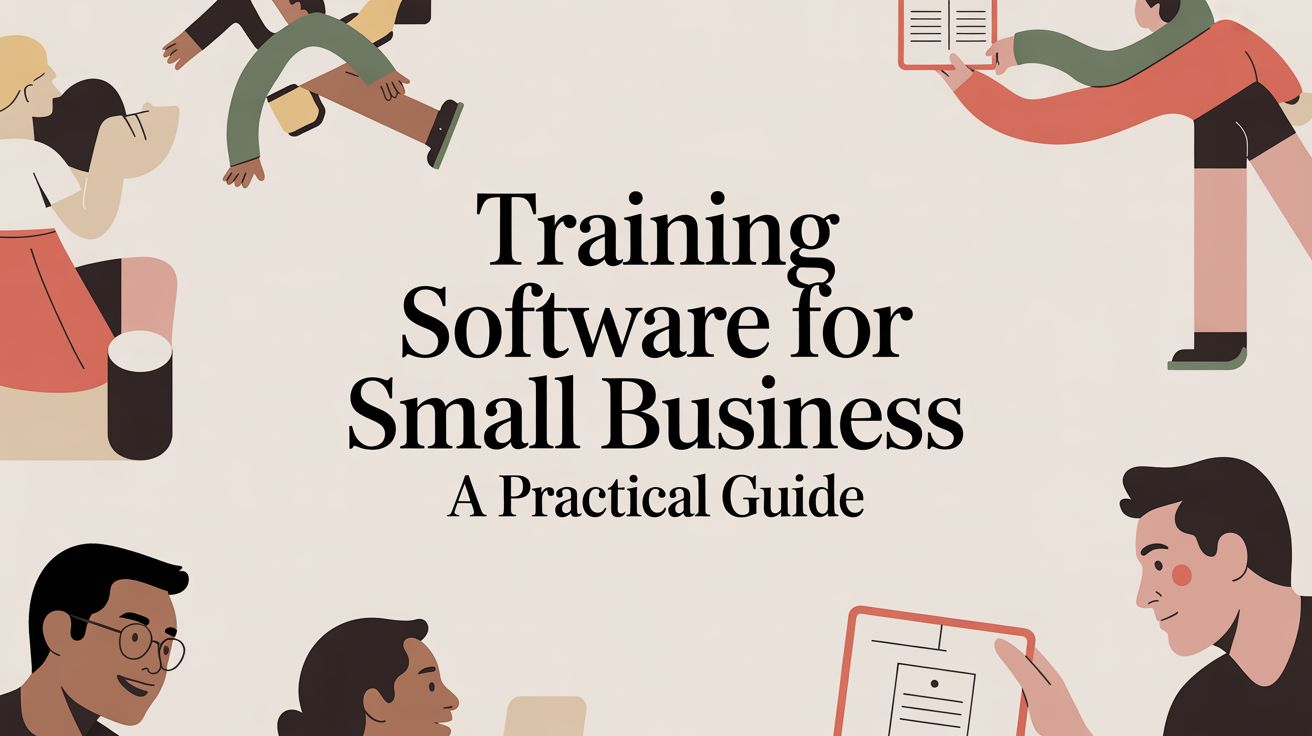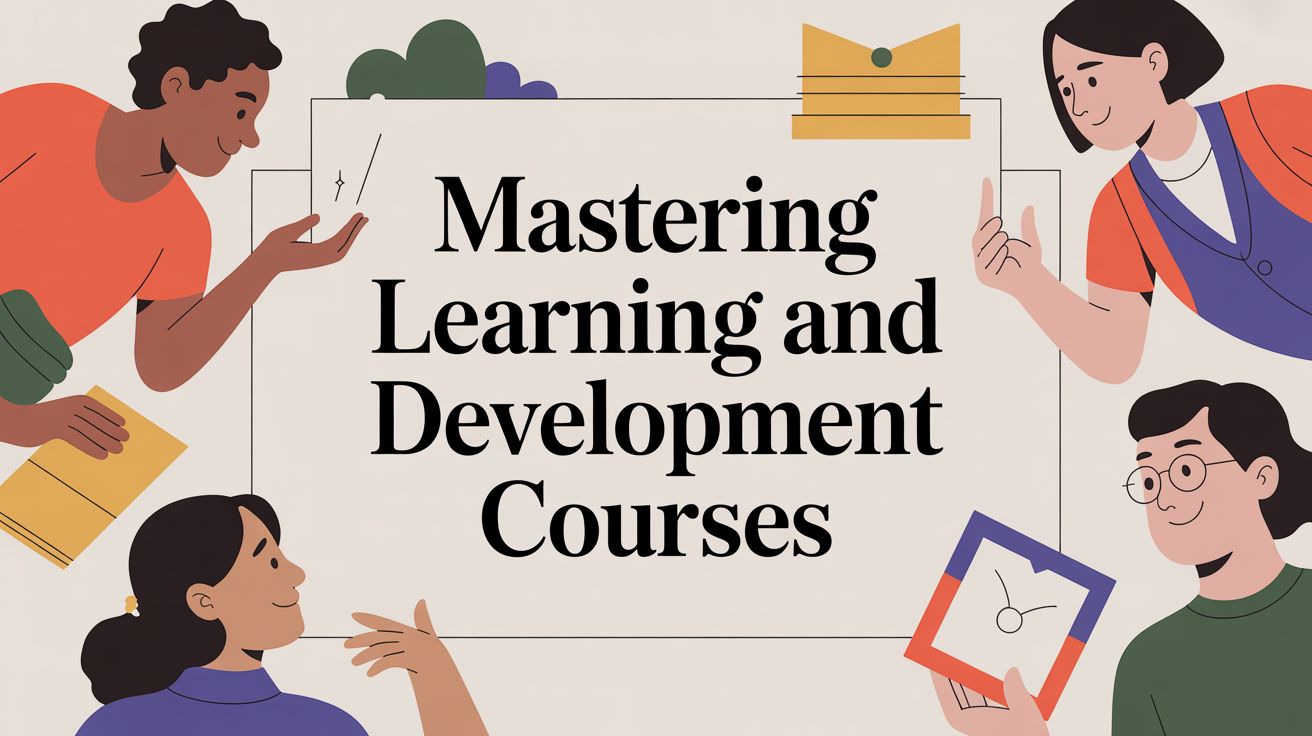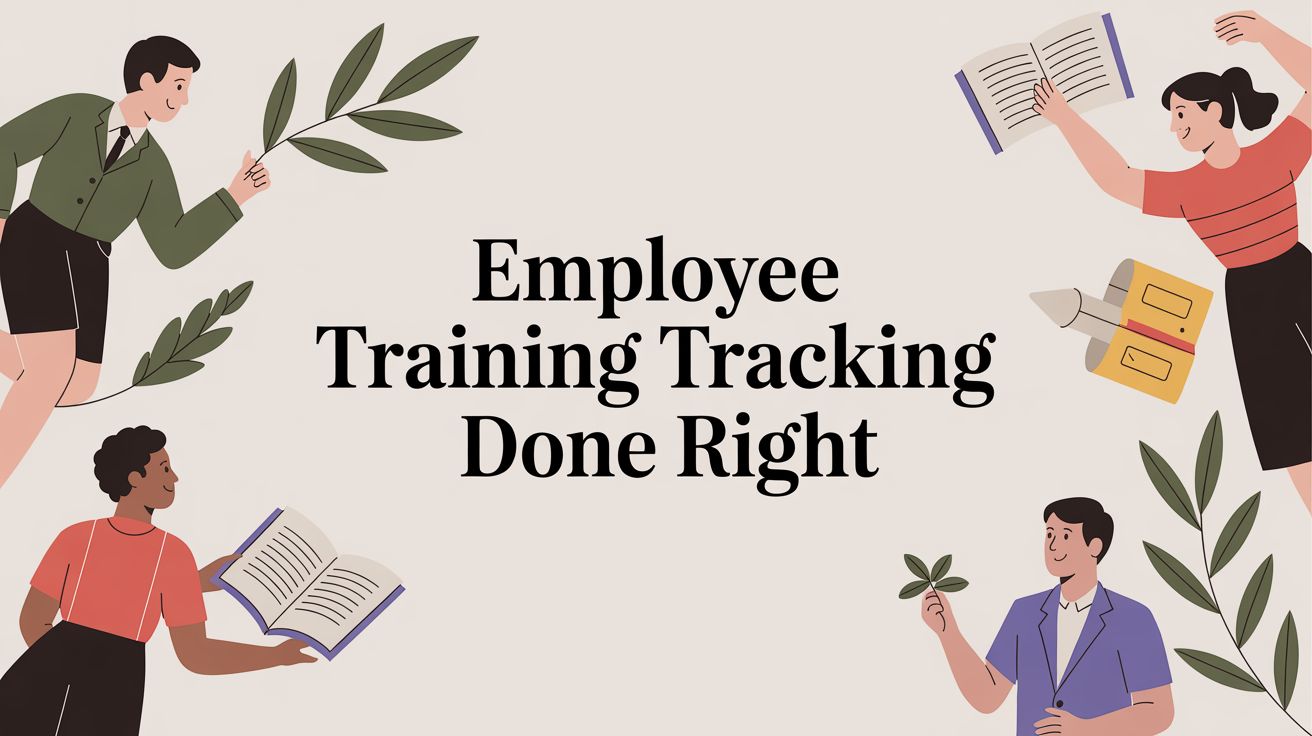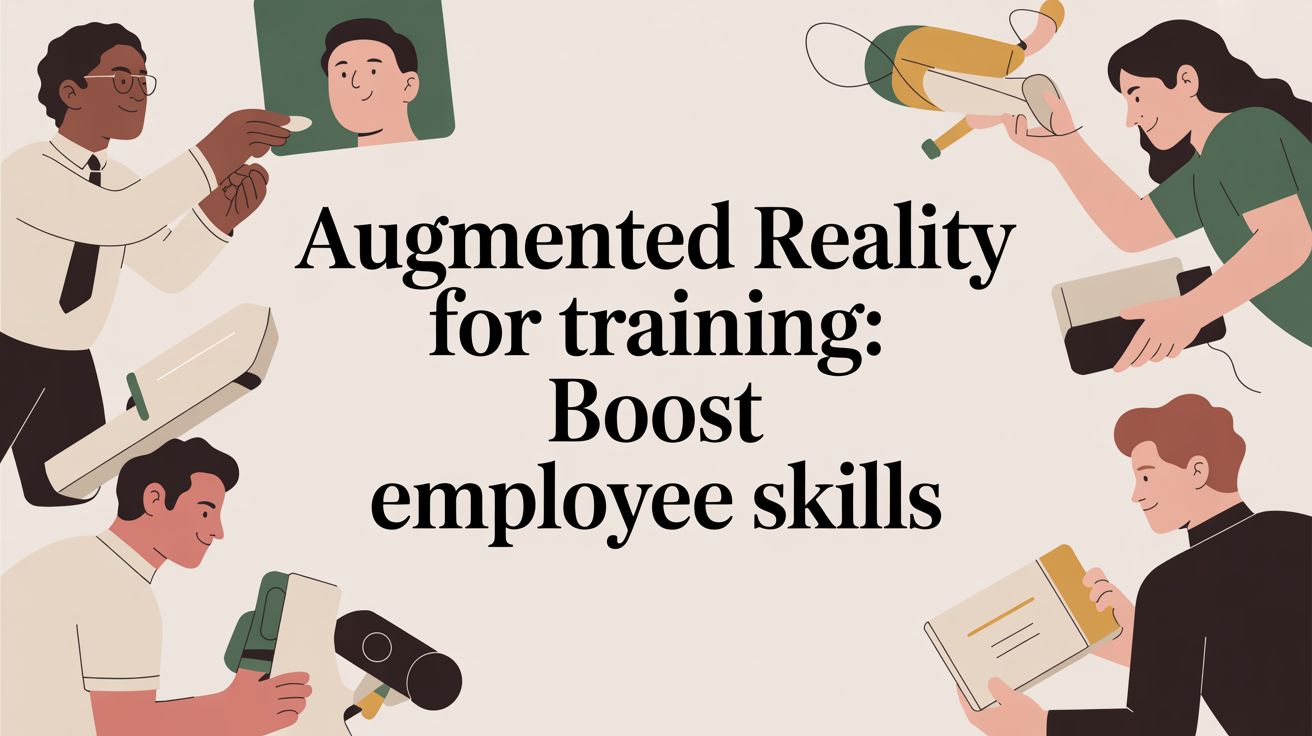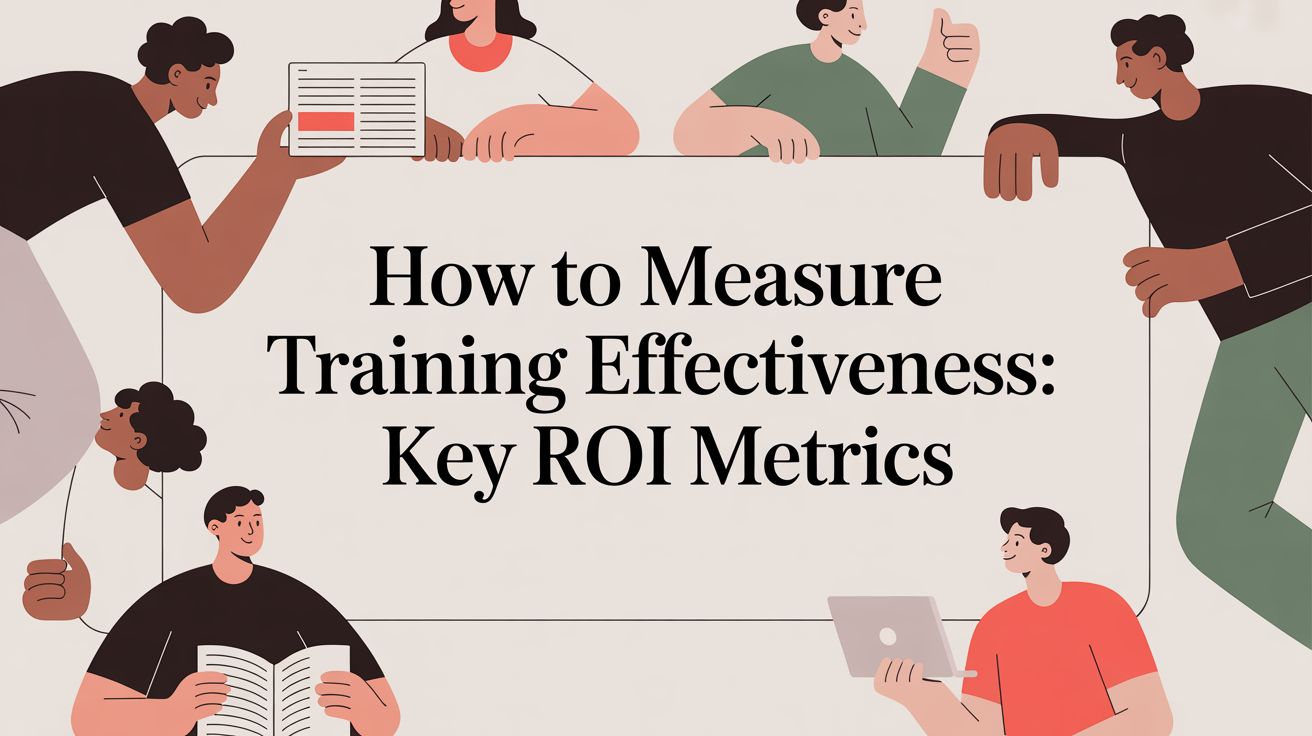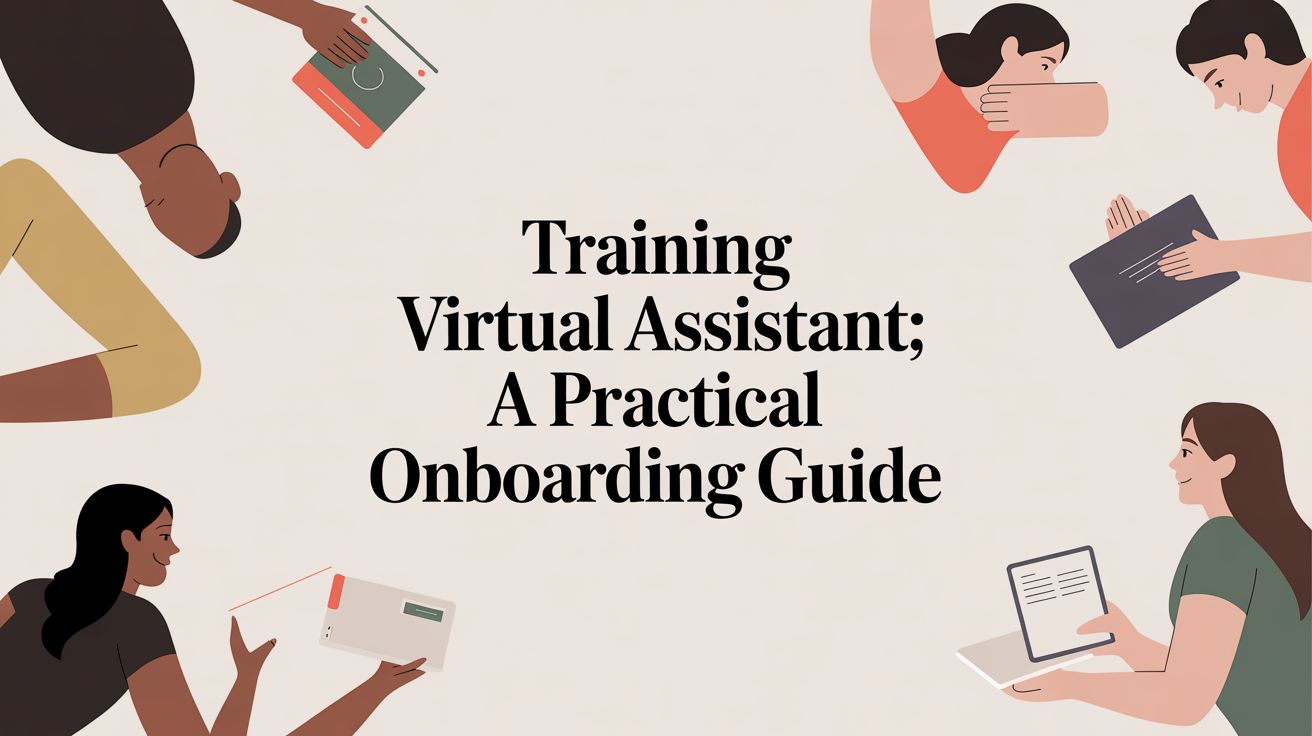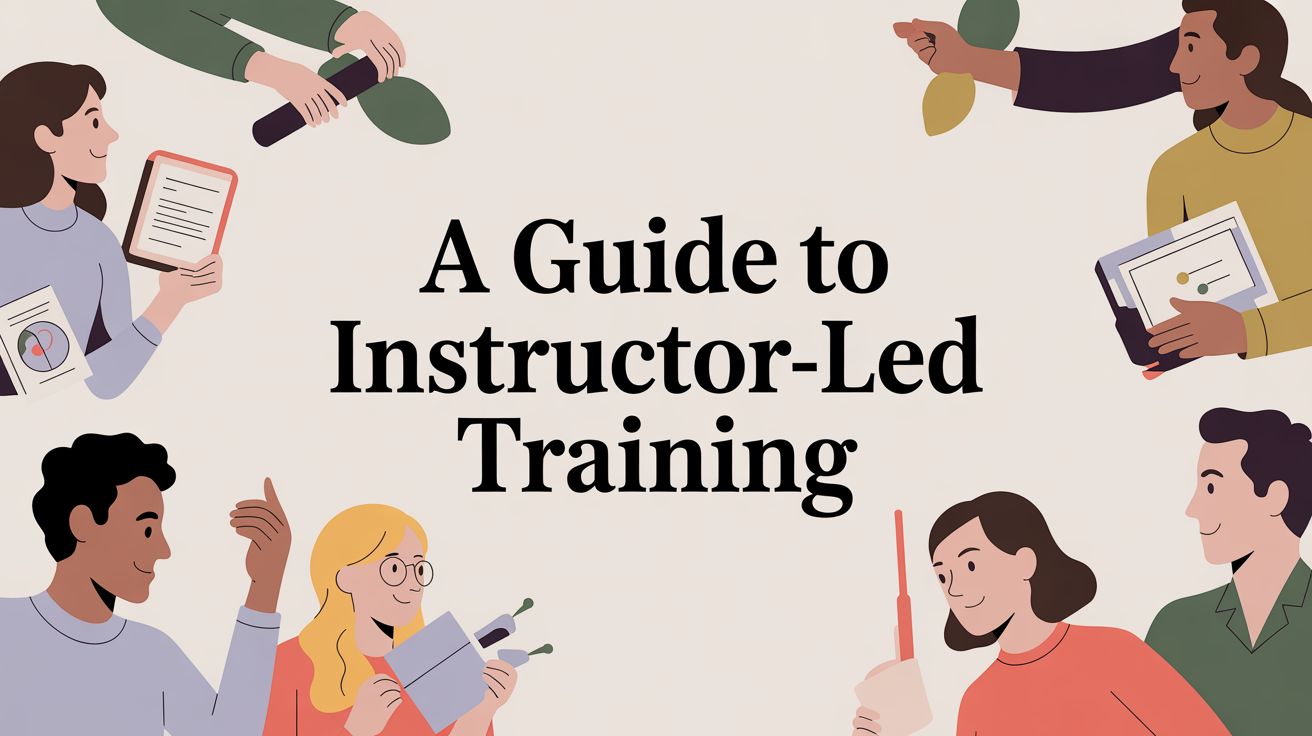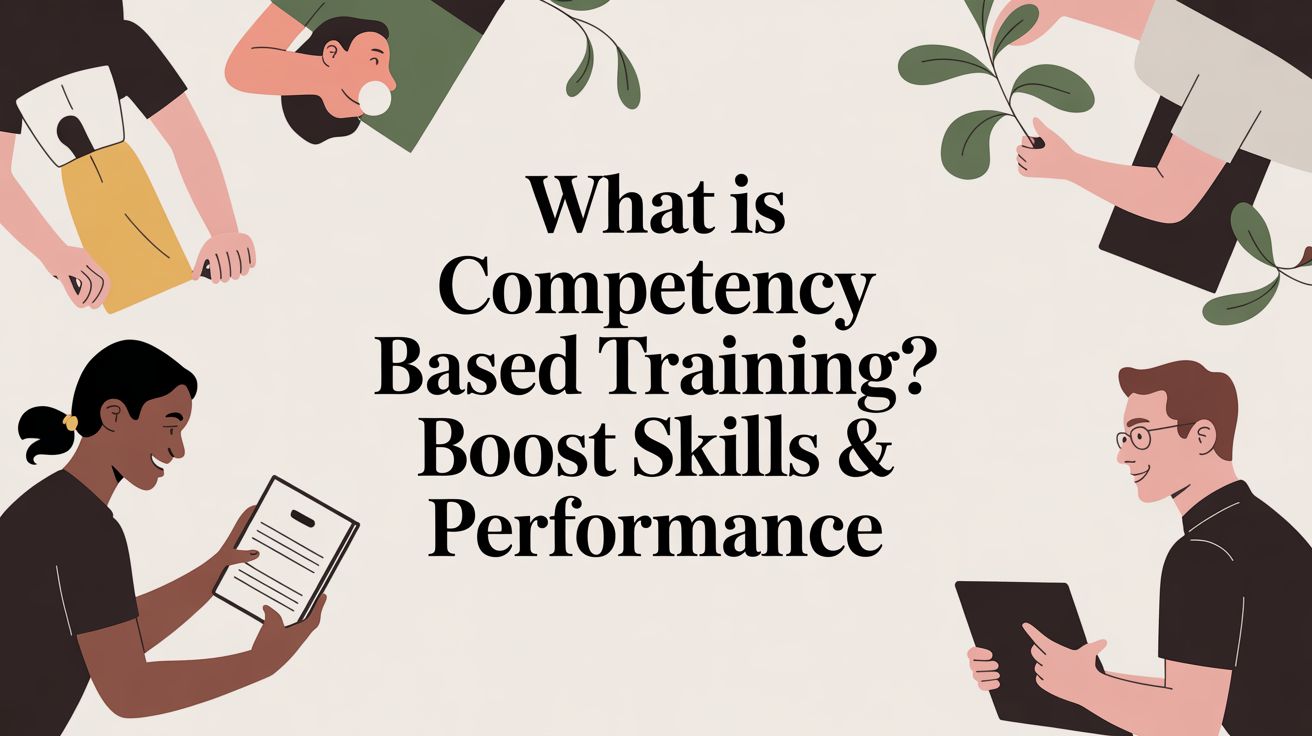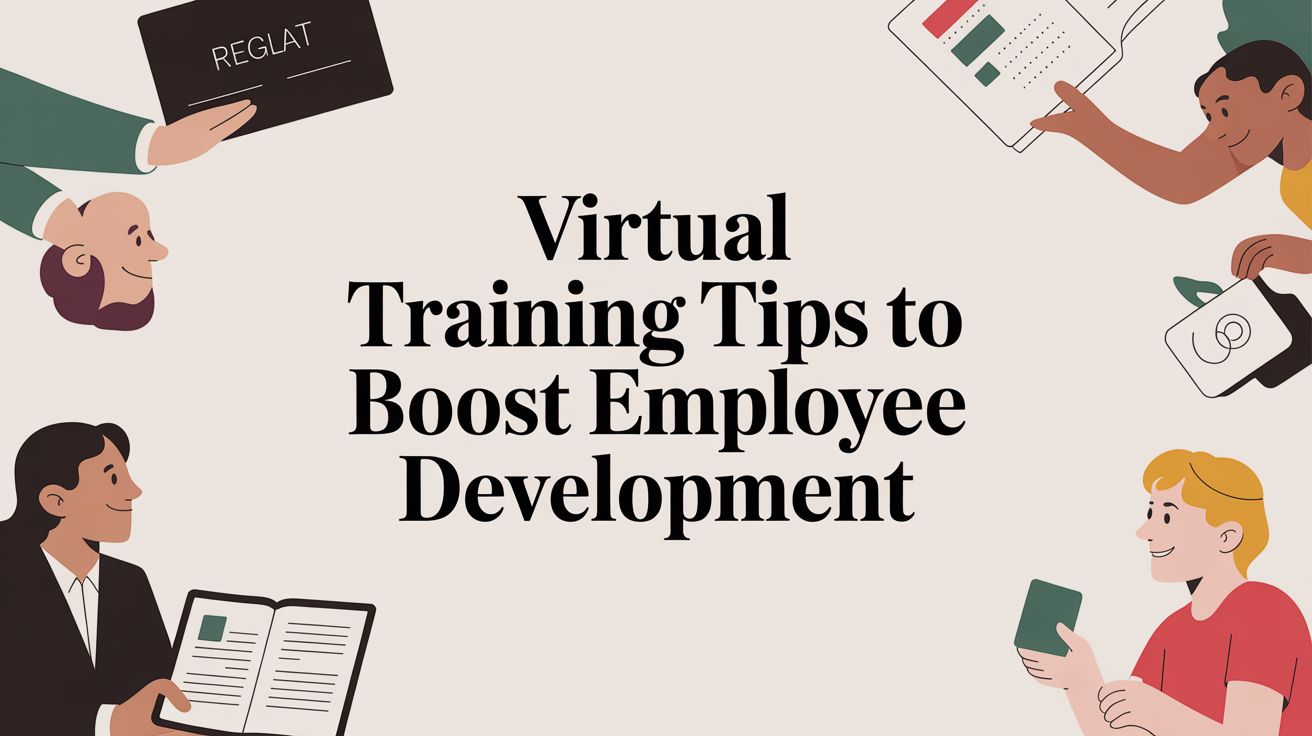Crafting Effective Evaluation Forms for Training Courses
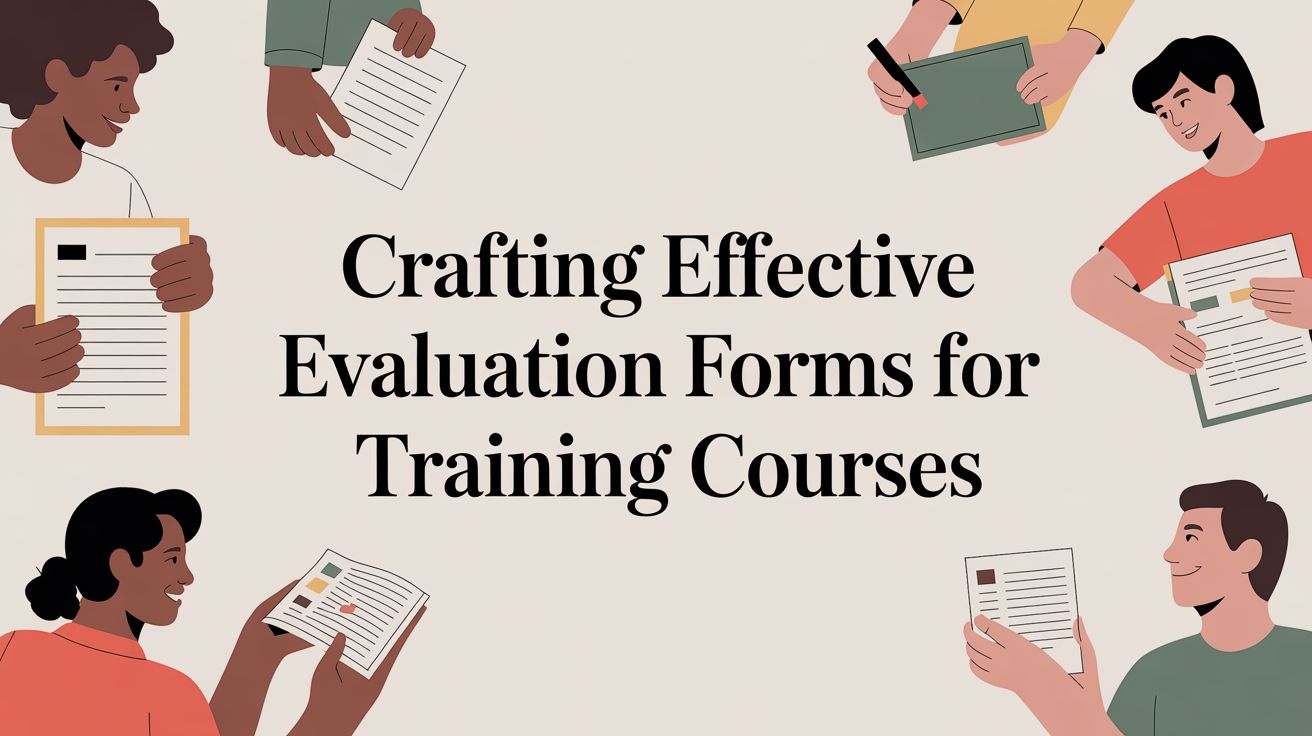
We've all been there. It's the end of a training day, and someone hands you a form. You tick a few boxes, maybe write a quick comment, and hand it back, eager to get on with your day. For years, these evaluation forms for training courses have felt like a mere formality—little more than "happy sheets."
But what if I told you that form, when done right, is one of the most powerful tools you have? When designed strategically, it’s the key to proving your training’s value and making real, measurable improvements.
Moving Beyond Basic Feedback Forms
The biggest flaw in most traditional feedback forms is that they ask the wrong questions. They're stuck on surface-level satisfaction ("Did you enjoy the coffee and biscuits?") instead of digging into true impact ("What will you do differently on Monday morning with what you've learned?"). This guide is all about leaving the generic happy sheet behind.
We're going to build evaluation forms that give you actionable data—the kind of insights that actually improve your next training session and prove its value to the people signing the checks.

Why Strategic Evaluation Matters
A well-crafted evaluation form is so much more than a report card for the trainer. It's a critical feedback loop that ties the training room directly to on-the-job performance and, ultimately, to business goals. You're no longer just collecting opinions; you're gathering intelligence that drives growth.
This is why structured evaluation remains a cornerstone of effective training worldwide. In fact, recent statistics show that nearly 85% of companies deploy these forms right after training to get immediate feedback on the content, instructor, and overall engagement. You can dig deeper into these employee training statistics and trends to see the bigger picture.
When you get strategic, your form helps you:
- Measure Knowledge Transfer: Did they actually get it? Can they use the new skills?
- Assess Instructor Performance: Get specific, constructive feedback to help your trainers shine.
- Validate Content Relevance: Was the material practical and directly useful for their day-to-day jobs?
- Justify Training Investment: Give stakeholders the hard data they need to see the program's ROI.
To illustrate the difference, think about what you learn from a basic form versus a strategic one.
From Basic Feedback to Business Impact
| Metric | Basic 'Happy Sheet' | Structured Evaluation Form |
|---|---|---|
| Knowledge Gain | "The content was interesting." (Subjective opinion) | "Rate your confidence in applying the XYZ model (from 1-5, before vs. after)." (Quantifiable change) |
| Relevance | "Did you enjoy the course?" (Measures satisfaction) | "Which module will be most useful in your current role and why?" (Ties learning to application) |
| Instructor Feedback | "The instructor was good." (Vague compliment) | "Provide one example of how the instructor clarified a complex topic for you." (Actionable feedback) |
| Business Impact | "Would you recommend this course?" (General sentiment) | "Identify one process you will change in the next 30 days based on this training." (Measures behavioral intent) |
As you can see, the quality of the data is night and day. One gives you a vague sense of satisfaction, while the other provides a roadmap for improvement and a case for business impact.
The Role of a Training Management System
Trying to manage all this with paper forms or a clunky mix of spreadsheets and survey tools is a recipe for headaches. It's inefficient, slow, and makes analyzing the data a nightmare. This is where a training management system (TMS) becomes a game-changer, especially for providers running instructor-led training.
A modern TMS takes the entire feedback process off your plate. Imagine forms being sent automatically the second a course ends, hitting participants' inboxes while the experience is still fresh in their minds. This simple automation can dramatically boost your response rates.
Systems like Coursebricks, a TMS built specifically for instructor-led training, are designed from the ground up to handle the logistics of live, virtual, and hybrid courses. They centralize the whole evaluation workflow, turning a tedious manual task into a smooth, automated process. This frees you up to focus on what really matters: analyzing the insights and making data-driven decisions.
Frame Your Goals with the Kirkpatrick Model
Before you even think about drafting your first question, you need to know what you're aiming for. Just asking if people "liked" the training barely scratches the surface. If you want data that actually tells a story and drives improvement, you need a solid framework. That’s exactly where the Kirkpatrick Model comes in.
It’s one of the most trusted and widely used models for evaluating training, and for good reason. It breaks down a program's impact into four clear, distinct levels. Most companies—somewhere around 70-80%—still rely on Level 1 "happy sheets" to gauge immediate satisfaction. While that’s a decent starting point, you can learn more about where that fits into the bigger picture by exploring common training evaluation methods and their effectiveness.
To get truly meaningful insights, you have to look beyond just smiles and thumbs-ups. The model gives you a roadmap to design questions that measure the full impact of your training, turning your evaluation form from a simple checkbox exercise into a strategic tool.
Level 1: Reaction
The first level, Reaction, is all about how participants felt about the training experience. But this goes deeper than just asking if they had a good time. A well-designed evaluation should probe into the specifics of the learning environment itself.
You'll want to ask questions that get at things like:
- Logistics: Was the room comfortable? For virtual sessions, was the platform easy to navigate?
- Pacing: Did the training feel rushed, or did it drag on?
- Instructor: Was the facilitator engaging? Did they encourage questions and create a good learning atmosphere?
This level gives you that immediate, on-the-ground feedback. If you're running multiple live courses, this data is gold for making quick fixes to things like room setup, tech, or even instructor delivery, ensuring the next session is even better.
Level 2: Learning
With Learning, we shift from feelings to facts. Did your participants actually walk away with the knowledge, skills, or attitudes you intended to teach? Your form needs questions that can actually measure this transfer of knowledge.
Don't just ask, "Did you learn something new?" That's too vague. Get specific with prompts like:
- "On a scale of 1-5, how would you rate your confidence in [specific skill] before this training?"
- "And on a scale of 1-5, how would you rate your confidence in that same skill after this training?"
- You could even include a short-answer question asking them to apply a key concept they just learned.
The goal here is to capture that immediate cognitive jump.
Pro Tip: That 'before and after' comparison is incredibly powerful. It turns a subjective feeling of "I think I learned something" into a hard data point you can actually show to stakeholders.
Level 3: Behavior
Behavior is where the training rubber really meets the road. Are people taking what they learned in the classroom and applying it back in their daily work? This isn't something you can measure as they're walking out the door.
To assess this level, your best bet is a follow-up survey, typically sent 30 to 60 days after the training concludes. This gives everyone enough time to put their new skills into practice. The questions here should be direct and focused on application. For instance, "Can you describe one time in the last month where you used the [new technique] we covered in the course?"
Level 4: Results
Finally, Results is the level that gets executives' attention. This is where you connect the training directly to tangible business outcomes. We're talking about the big-picture stuff—increased sales, fewer production errors, higher customer satisfaction scores.
Measuring this often requires a bit more legwork, like partnering with department heads to analyze performance data before and after the training. While it's the most challenging level to measure, successfully linking training to key business metrics is the most powerful way to prove its value and secure your budget for next year.
Writing Questions That Generate Actionable Insights
Let's be honest: the data you get from your evaluation forms for training courses is only as good as the questions you ask. If you ask vague, generic questions, you'll get vague, generic answers that are impossible to act on. To get feedback that actually drives improvement, you have to move beyond lazy queries and start writing specific, measurable prompts.
This is all about understanding how to ask better questions. It’s a skill that can turn a simple form from a checkbox exercise into a powerful tool for gathering real business intelligence. You're shifting from just collecting opinions to collecting hard evidence.
Combining Quantitative and Qualitative Questions
A truly effective evaluation form needs a healthy mix of both quantitative and qualitative questions. Think of them as two sides of the same coin—each gives you a different piece of the puzzle, and you need both to see the whole picture.
Quantitative questions are your numbers—the scales (like a 1-5 Likert scale) and yes/no answers. They're fantastic for spotting trends at a glance. For instance, if 85% of participants rate the instructor's knowledge as a 5/5, you've clearly got a subject matter expert leading the session.
On the other hand, qualitative questions are your open-ended prompts. They dig into the "why" and "how," inviting people to share detailed stories and specific examples. This is where you find the gold—the unexpected insights and powerful anecdotes that numbers alone could never reveal.
Expert Tip: I always make it a rule to follow up a low quantitative score with a targeted qualitative question. If someone rates the course materials a 2 out of 5, the very next question should be something like, "What specific improvements could we make to the course materials?" This immediately pinpoints the problem so you can fix it.
From Vague to Valuable: Question Makeovers
Let’s look at how to transform your questions from fluffy to functional. The goal is to get away from broad satisfaction queries and move toward prompts that measure confidence, application, and real-world behavioral intent.
Here are a few real-world examples from my own experience:
Before (Vague): "Was the training good?"
- This question is a dead end. "Good" means something different to everyone and gives you zero actionable data.
After (Specific & Actionable): "On a scale of 1-5, how confident are you in applying the new sales technique with a client tomorrow?"
- Now we're talking. This measures immediate confidence and directly links the training to on-the-job performance.
Before (Vague): "Did you find the content useful?"
- Again, "useful" is far too broad. It doesn't tell you what was useful or why.
After (Specific & Actionable): "Which module from today's session will have the most immediate impact on your daily work, and why?"
- This forces the participant to pinpoint a specific takeaway and explain its real-world application. That's concrete evidence of your training's relevance.
Question Types and Their Strategic Use
Choosing the right question format is just as important as the question itself. Different formats are better suited for measuring different outcomes, especially when thinking about the Kirkpatrick levels of evaluation.
Here’s a quick-reference table I use to guide my selection process.
| Question Type | Best For Measuring | Example Question |
|---|---|---|
| Likert Scale | Kirkpatrick Level 1 (Reaction): Gauging satisfaction, confidence, and agreement. | "On a scale of 1 (Strongly Disagree) to 5 (Strongly Agree), the training objectives were clear." |
| Multiple Choice | Kirkpatrick Level 2 (Learning): Assessing knowledge retention and understanding of concepts. | "Which of the following is the first step in our new client onboarding process?" |
| Open-Ended | Kirkpatrick Level 3 (Behavior): Uncovering intended application and specific takeaways. | "What is one thing you will do differently in your job next week as a result of this training?" |
| Yes/No | Quickly segmenting data or confirming completion of prerequisites. | "Did you complete the pre-work module before attending this session?" |
This table helps ensure you're not just asking questions, but asking the right questions to get the specific feedback you need at each level of evaluation.
Common Traps to Avoid When Writing Questions
Even seasoned pros can fall into a few common traps that can completely skew their results. Be on the lookout for these mistakes:
- Leading Questions: Watch your phrasing. A question like, "How amazing was our fantastic instructor?" is basically begging for a positive response and taints the data. Keep it neutral.
- Double-Barreled Questions: This is a classic mistake. Never ask two things at once, like "Was the instructor knowledgeable and engaging?" Someone might think they were knowledgeable but dull, leaving them unsure how to answer. Always split these into two separate questions.
- Internal Jargon: Write for your audience. Avoid company acronyms or technical terms that might confuse participants. When people don't understand the question, they either skip it or give an inaccurate answer.
Designing Forms That People Actually Complete
Let's be honest: even the best questions won't get answered if your evaluation form is a pain to fill out. A clean, intuitive design isn’t just a nice-to-have; it's the single biggest factor that will make or break your response rates. If a form looks cluttered or feels like it's going to take forever, people will either rush through it without thinking or just close the tab.
The goal is to make giving feedback feel effortless. That process starts with a logical structure. Think about grouping related questions into clear sections—for example, Instructor, Content, and Logistics. This simple step helps the form feel organized and way less overwhelming. It allows participants to focus on one thing at a time, which almost always leads to more thoughtful, useful feedback.
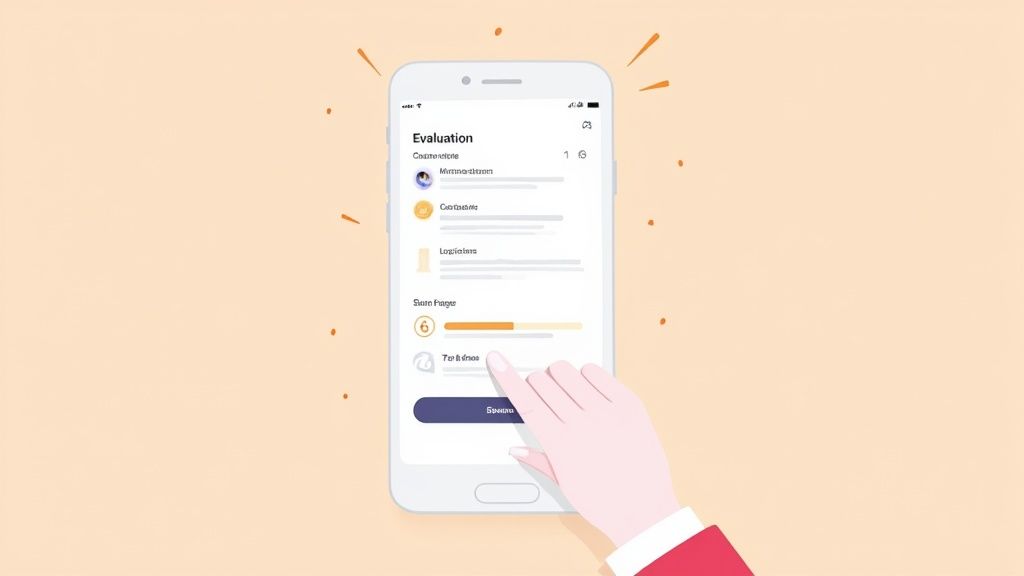
Respecting the Participant's Time
Everyone is busy, especially right after a training session ends. You have a very small window to capture their thoughts. From my experience, the sweet spot for completion time is somewhere between 5 and 7 minutes. Push it any longer, and you'll run headfirst into survey fatigue, which is where your data quality takes a nosedive. Keeping your evaluation forms for training courses short and to the point shows you value their time.
One of the simplest but most effective psychological tricks you can use is a progress bar. It seems minor, but seeing a visual indicator of how much is left gives people a sense of forward momentum and encourages them to finish. It silently answers that nagging question, "How much longer is this going to take?"
Pro Tip: Never underestimate the power of white space. A form with questions crammed together is visually exhausting. Giving each element room to breathe makes the whole thing more readable and less intimidating, which dramatically improves the user experience.
Leveraging Technology for a Better Experience
Creating, sending, and chasing down feedback forms by hand is a massive time sink. This is exactly where a dedicated Training Management System (TMS)—one built specifically for instructor-led and hybrid training, like Coursebricks—really shines.
A good TMS automates the entire feedback loop. Forget fiddling with clunky design tools. You can use professional, pre-built templates that are already optimized for a great user experience. Not only do these templates look clean and logical, but they're also mobile-friendly by default—a must, since a huge chunk of your participants will likely fill them out on their phones. This is just one way technology can make your sessions more engaging, a topic we dive into in our guide to creating more interactive training experiences.
Using a system like Coursebricks does more than just save you administrative headaches. It ensures every single participant gets a polished, easy-to-use form. That professional touch reflects well on your brand and, more importantly, helps you get the maximum quantity—and quality—of feedback possible.
Turning Raw Feedback into Strategic Decisions
Collecting feedback from your evaluation forms for training courses is one thing; knowing what to do with it is another. The real magic happens when you move beyond a simple pile of responses and start weaving a clear story about your training's effectiveness. This is where you turn raw data into actionable insights.
It's often easiest to start with the numbers. Quantitative data, like your rating scales, gives you that quick, high-level snapshot. I always begin by looking for trends. Calculate average scores for key areas—instructor performance, content relevance, facility comfort. If you see a consistently low score for a specific module popping up again and again, that's your first big clue that something needs a closer look.

Uncovering the Story in Qualitative Data
While numbers tell you what happened, the written comments tell you why. Sifting through open-ended feedback can feel like a chore, but there's a simple way to manage it. I like to group comments into recurring themes. Think of them as buckets: "Pacing," "Real-World Examples," "Technical Glitches," and so on.
Once you start sorting, patterns jump out at you. You might find that while an instructor scored high on ratings, three different people mentioned the pace felt rushed. That’s the kind of context you can't get from a number alone, and it's exactly what you need to make smart adjustments. For a more structured way to approach this, it's worth exploring a solid data-driven decision-making process.
Pro Tip: Don't forget to look for gold nuggets in the comments. A single quote like, "This is the first time a training course has given me a tool I can use tomorrow," is pure marketing magic and powerful proof of your program's value.
Centralizing Data with a Training Management System
Let's be honest, manually wrangling spreadsheets is a nightmare. It’s slow, tedious, and a recipe for mistakes. For any organization running regular instructor-led training, a training management system (TMS) like Coursebricks is a game-changer. It stops being about just collecting data and becomes your central hub for analysis.
A good TMS automates the heavy lifting. For instance, Coursebricks can:
- Generate real-time reports that show you trends and averages at a glance.
- Compare instructor performance across different courses and over time.
- Track feedback historically so you can see if the changes you made are actually working.
This automation turns a complex analytical job into a simple workflow. You can quickly pull clear, visual reports to share with stakeholders, proving the value of your programs. Ultimately, it lets you spend less time buried in numbers and more time making smart decisions that truly improve the learning experience.
Answering Your Top Questions About Training Evaluation Forms
As you start building better evaluation forms, you'll likely run into a few common questions. I see these pop up all the time. Getting the answers right can make the difference between collecting random feedback and gathering real, actionable intelligence. Let's dig into the big ones.
How Long Should an Evaluation Form Be?
This is probably the most frequent question I get. The golden rule? Respect your learners' time.
Aim for a form that takes no more than 5-7 minutes to complete. In my experience, this usually means sticking to 10-15 well-crafted questions. If you go much longer, you'll hit the law of diminishing returns. People will either ditch the form halfway through or just click random buttons to get it over with, which ruins your data quality.
A simple trick to make it feel even shorter is to group your questions into logical buckets like "About the Instructor," "Course Content," and "Overall Experience." This small organizational tweak makes the whole thing feel less like a chore.
When Is the Best Time to Send the Form?
Timing is everything, especially when you want to capture that immediate, gut-reaction feedback.
The ideal moment to send the evaluation is right after the training session wraps up. Don't wait. You want to catch people while the content is still fresh in their minds. This is your best shot at measuring what Kirkpatrick's model calls Level 1 (Reaction)—how they felt about the training.
A good training management system can be your best friend here. For example, a platform like Coursebricks can be set up to automatically send the evaluation email the second an instructor marks the course as complete. This way, you never miss that critical feedback window.
How Do I Measure the Real, Long-Term Impact?
A single, post-course survey is great for capturing initial reactions, but it won't tell you if anything actually changed back on the job. That’s where you need to think about measuring Kirkpatrick's Level 3 (Behavior).
The best way to do this is with a follow-up.
Plan on sending a second, much shorter survey about 30-90 days after the training. This one should be hyper-focused on application. Instead of asking if they liked the content, ask how they've used it.
A question like, "Describe one process you have changed based on what you learned in the session," can give you incredibly valuable insight into whether the training actually stuck. While a training management system is designed for instructor-led courses, many tools offer similar features. If you're exploring different platforms, our guide on the best systems for corporate training can help you compare options.
Ready to explore Coursebricks?
Manage training programs, automate emails, and generate detailed reports — all in one place.




